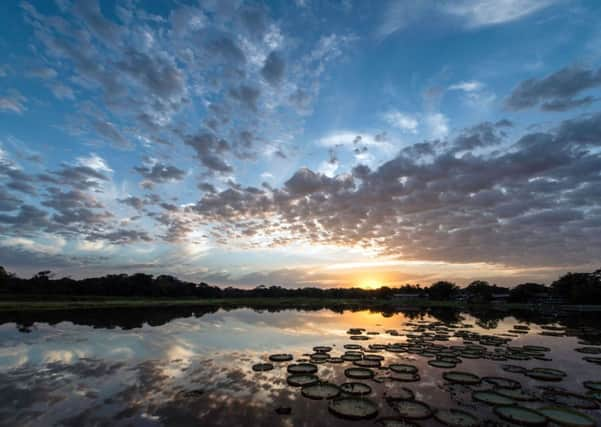On the big cat trail in Brazil


As the pink dust clouds settle, a weathered cowboy and his herd of cattle come into view.
Like us, they’re travelling along the Transpantaneira, the single bumpy dirt track that cuts through the Brazilian Pantanal and the state of Mato Grosso. Wild, harsh and largely impenetrable, South America’s Pantanal is the world’s biggest swamp – stretching across Brazil, but spilling into Bolivia and Paraguay – and the continent’s richest source of wildlife.
Advertisement
Hide AdAdvertisement
Hide AdOnce used mainly by farmers and wealthy sports fishermen, who come to cast off in the area’s many waterways, the 90-mile Transpantaneira now attracts increasing tourist traffic, the majority searching for the Pantanal’s most awe-inspiring resident: the jaguar.
As our journey takes us deeper into the thorny scrub, we pass a large water hole speckled with Jabiru storks touching down and taking off in quick succession.
Hundreds upon hundreds of gnarly-skinned caimans lie motionless in the shallow water, mouths open as if catching one of the many encircling flies. When the swamps dry out completely in September and October, they will remain submerged in the mud for three to four months. A lack of water also drives jaguars to the riverbanks, giving wildlife enthusiasts the best opportunities for sightings during this dry season.
Sat on the banks of the Cuiaba river, at the end of the Transpantaneira, Porto Jofre is one of the best bases for jaguar tours. Accompanied by Juan Silva da Cruz, one of the region’s most knowledgeable and passionate guides, we set off on our first outing at 5.30am, accompanied by a chattering soundtrack of birdsong.
Advertisement
Hide AdAdvertisement
Hide AdSadly, luck is not on our side and we return home without seeing one of the big cats. The journey back, though, is far from disappointing. Silhouetted by the setting sun, parched trees appear charred by the burning red sky, as clouds coil like plumes of cigar smoke, twisting and curling upwards.
Nothing can detract from the beauty of this place.
Estimates suggest there are 7,000 jaguars in the Pantanal, Juan tells me, but he suspects there are many more, so our outlook for the days ahead is positive.
The following morning we head to the Black Water Stream, just off the Three Brothers River. Slowing down the engine, we slowly scan the riverbanks. It’s at this point that I really appreciate having a local guide. Most tourists’ attempts at spotting are pitiful; directing someone to look at ‘that branch’ in dense forest, or ‘over there by that triangle’ isn’t particularly helpful.
“Using local guides not only gives you the best chance to see jaguars,” says Juan, whose grandfather owned a ranch in the area, “but if locals benefit financially, it also helps educate the community about conservation.”
Advertisement
Hide AdAdvertisement
Hide AdHe’s referring to the fact that before jaguars became the focus of a lucrative tourist industry, they were considered a nuisance for killing cattle and were often shot dead. Then there it is, a flash of a sleek tawny pelt covered in darker rosettes. We sit, and wait. Patience is, after all, the key to wildlife rewards.
As midday approaches, the sun burns at an uncomfortable 34C. Wedged at a 45-degree angle, my knees start to cramp, while meaty black flies feast on my arms and legs.
Finally, the stocky, brash young male slowly saunters into the open, turning his muscular head in our direction and locking his gaze. His power is quite humbling; his jaw so strong, it can crack a caiman’s skull. “You can actually hear it crunch,” shudders Juan. Slinking back into the bushes, the apex predator licks his paws and rolls on his back like a domestic cat.
It’s the first of 13 sightings. From the jaguar swimming through reeds in pursuit of a capybara, to a hulking male sunbathing on a sandbank, every encounter is as charged and exhilarating as the last.
Advertisement
Hide AdAdvertisement
Hide AdAccording to Andre von Thuronyi, who runs a farm and the Araras ecolodge, it’s becoming much easier to see these animals in the wild. “It took me 11 years to see my first jaguar, now they’re everywhere,” he tells me.
Armadillo, tapir and deer are just a few of the creatures seen in his hotel grounds, and at breakfast we’re joined by dozens of red-crested cardinals, some so bold they even perch on salt cellars.
“People think I’m crazy to live here,” he laughs. “Brazilians don’t come here; they think it’s full of flies and insects.”
I have to agree. But for me, that’s the very draw of this impossibly beautiful part of the world.
All creatures great and small, the Pantanal has them in abundance